Three-Dimensional Morphology and Analysis of Widmanstätten Sideplates Ferrite
Abstract
:1. Introduction
2. Materials and Methods
2.1. FIB Sample Preparation
2.2. Experimentation
3. Results and Discussion
3.1. Primary Widmanstätten Sideplates
3.2. Secondary Widmanstätten Sideplates
4. Conclusions
Author Contributions
Funding
Data Availability Statement
Acknowledgments
Conflicts of Interest
References
- Komine, S.; Sekido, K.; Inoue, J. In-situ measurement of surface relief induced by Widmanstätten and bainitic ferrites in low carbon steel by digital holographic microscopy. Scr. Mater. 2019, 162, 241–245. [Google Scholar] [CrossRef]
- Jonas, J.J.; He, Y.; Langelaan, G. The rotation axes and angles involved in the formation of self-accommodating plates of Widmanstätten ferrite. Acta Mater. 2014, 72, 13–21. [Google Scholar] [CrossRef]
- Lin, C.; Wan, J.; Ruan, H. Phase field modeling of Widmanstätten ferrite formation in steel. J. Alloys Compd. 2018, 769, 620–630. [Google Scholar] [CrossRef]
- Hillert, M.; Höglund, L.; Ågren, J. Diffusion-controlled lengthening of Widmanstätten plates. Acta Mater. 2003, 51, 2089–2095. [Google Scholar] [CrossRef]
- Guofang, Q.; Zhanli, D.; Yan, F. Cooling control optimization of widmanstatten structure and mixed crystal structure elimination of swrch35k hot rolled wire rod. Henan Metall. 2020, 28, 14–16. [Google Scholar]
- Kral, M.V.; Spanos, G. Three-dimensional analysis of proeutectoid cementite precipitates. Acta Mater. 1999, 47, 711–724. [Google Scholar] [CrossRef]
- Dube, C.A.; Aaronson, H.I.; Mehl, R.F. La formation de la ferrite proeutectoide dans les aciers au carbone. Rev. De Métallurgie 1958, 55, 201–210. [Google Scholar] [CrossRef]
- Aaronson, H.I. The Mechanism of Phase Transformation in Metals; Institute of Metals Monograph and Reports Series No.18; The Institute Of Metals: London, UK, 1956. [Google Scholar]
- Kaiming, W.U. Three-dimensional morphology and analysis of ferrite in steels. Chin. J. Stereol. Image Anal. 2017, 22, 119–126. [Google Scholar]
- Spanos, G.; Wilson, A.W.; Kral, M.V. New insights into the widmanstätten proeutectoid ferrite transformation: Integration of crystallographic and three-dimensional morphological observations. Metall. Mater. Trans. A 2005, 36, 1209–1218. [Google Scholar] [CrossRef]
- Kral, M.V.; Spanos, G. Three dimensional morphology of cementite precipitates. Scr. Mater. 1997, 36, 875–882. [Google Scholar] [CrossRef]
- Kral, M.V.; Spanos, G. Three-dimensional analysis and classification of grain boundary-nucleated proeutectoid ferrite precipitate. Metall. Mater. Trans. A 2005, 36, 1199–1207. [Google Scholar] [CrossRef]
- Cheng, L.; Wan, X.L.; Wu, K.M. Three-dimensional morphology of grain boundary Widmanstätten ferrite in a low carbon low alloy steel. Mater. Charact. 2010, 61, 192–197. [Google Scholar] [CrossRef]
- Cheng, L. The Nucleation, Three-Dimensional Morphology and Growth Kinetics in Low Carbon High Strength Micro-Alloyed steel. Ph.D. Thesis, Wuhan University of Science and Technology, Wuhan, China, 2013. [Google Scholar]
- Cheng, L.; Wu, K.M. New insight into intragranular ferrite in a low-carbon low-alloy steel. Acta Mater. 2009, 57, 3754–3762. [Google Scholar] [CrossRef]
- Hackenberg, R.E.; Nordstrom, D.P.; Shiflet, G.J. Morphology and three-dimensional structure of ferrite formed below the bay in an Fe–C–W alloy. Scr. Mater. 2002, 47, 357–361. [Google Scholar] [CrossRef]
- Jia, X.Z.; Wang, Y.; Xing, Y.; Liu, Q.; Liu, F.I.B. Three-dimensional characterization analysis techniques and its application progress. Mater. China 2013, 32, 735–741. [Google Scholar]
- Inkon, B.J.; Mulvihill, M.; Mobus, G. 3D determination of grain shape in a FeAl-based nanocomposite by 3D FIB tomography. Scr. Mater. 2001, 45, 753–758. [Google Scholar] [CrossRef]
- Villinger, C.; Gregorius, H.; Kranz, C.; Höhn, K.; Münzberg, C.; von Wichert, G.; Walther, P. FIB/SEM tomography with TEM-like resolution for 3D imaging of high-pressure frozen cell. Histochem. Cell Biol. 2012, 138, 549–556. [Google Scholar] [CrossRef]
- Uchic, M.D.; Groeber, M.A.; Dimiduk, D.M.; Simmons, J.P. 3D micro structural characterization of nickel superalloys via serial-sectioning using a dual beam FIB-SEM. Scr. Mater. 2006, 55, 23–28. [Google Scholar] [CrossRef]
- Cao, S.; Tirry, W.; Van Broek, D.; Schryvers, D. Optimization of a FIB/SEM slice-and-view study of the 3D distribution of Ni4Ti3 precipitates in Ni–Ti. J. Microsc. 2009, 233, 61–68. [Google Scholar] [CrossRef]
- Zankel, A.; Wagner, J.; Peter, P. Serial sectioning methods for 3D investigations in materials science. Micron 2014, 62, 66–78. [Google Scholar] [CrossRef]
- Groeber, M.A.; Haley, B.K.; Uchic, M.D. 3D reconstruction and characterization of polycrystalline microstructures using a FIB-SEM system. Mater. Charact. 2006, 57, 259–273. [Google Scholar] [CrossRef]
- Mingard, K.P.; Jones, H.G.; Gee, M.G. Metrological challenges for reconstruction of 3-D microstructures by focused ion beam tomography methods. J. Microsc. 2014, 253, 93–108. [Google Scholar] [CrossRef] [PubMed] [Green Version]
- Fan, G.H.; Zhang, Y.B.; Driver, J.H.; Jensen, D.J. Oriented growth during recrystallization revisited in three dimensions. Scr. Mater. 2014, 72/73, 9–12. [Google Scholar] [CrossRef]
- Wu, S.; Zhang, C.; Zhu, L.; Zhang, Q.; Ma, X. In-depth analysis of intragranular acicular ferrite three-dimensional morphology. Scr. Mater. 2020, 185, 61–65. [Google Scholar] [CrossRef]
- King, A.D.; Bell, T. Morphology and crystallography of Widmanstätten proeutecoid ferrite. Met. Sci. 1974, 8, 253–260. [Google Scholar] [CrossRef]

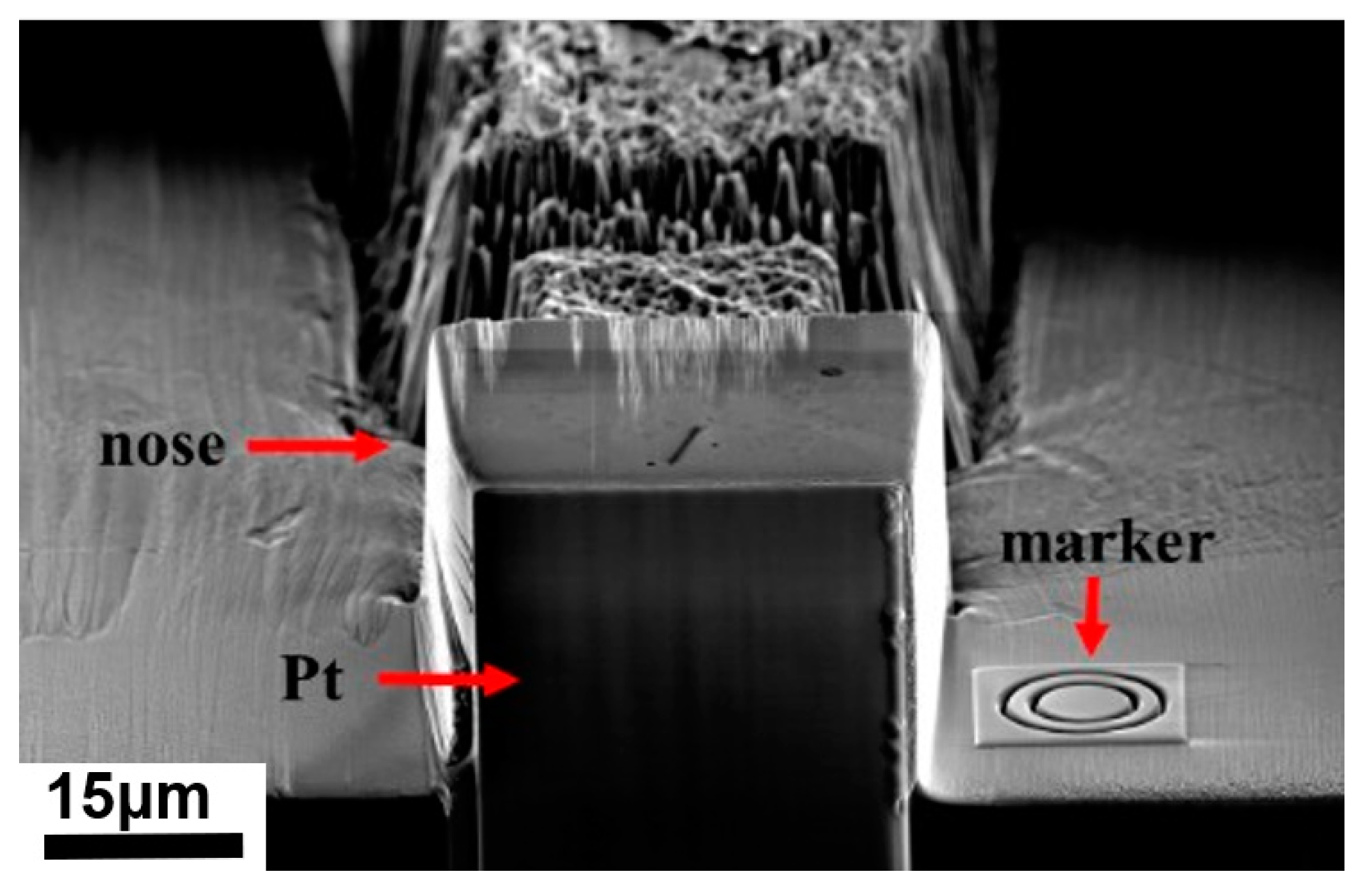
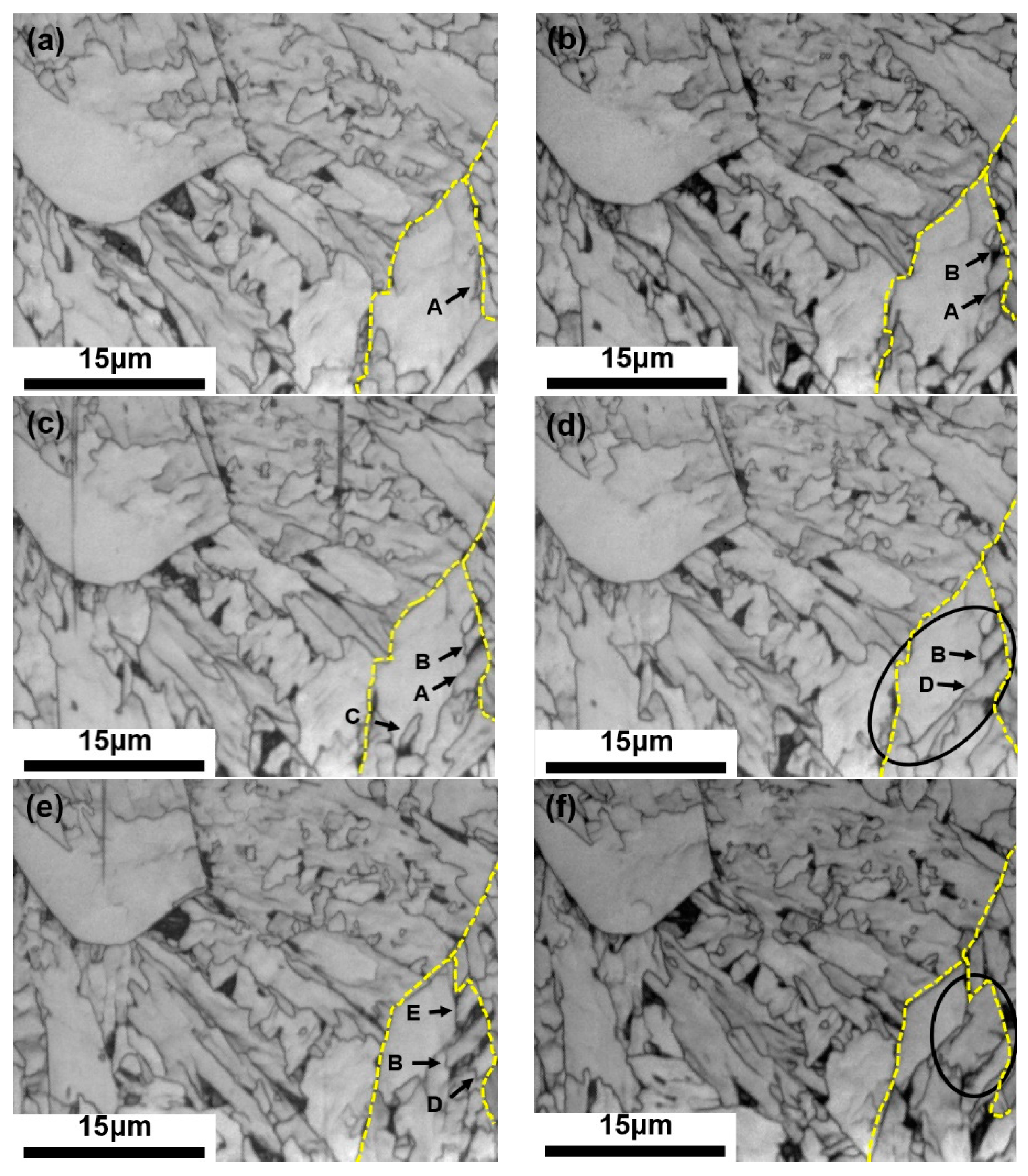
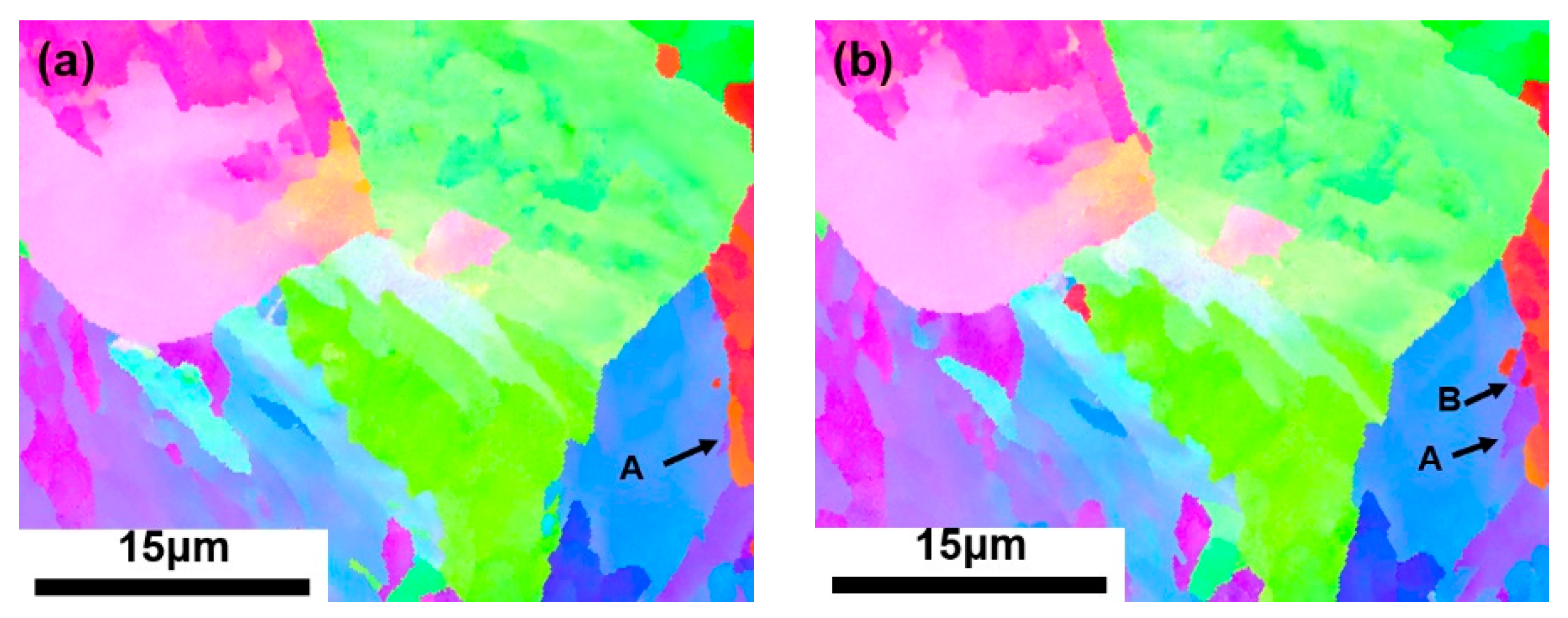
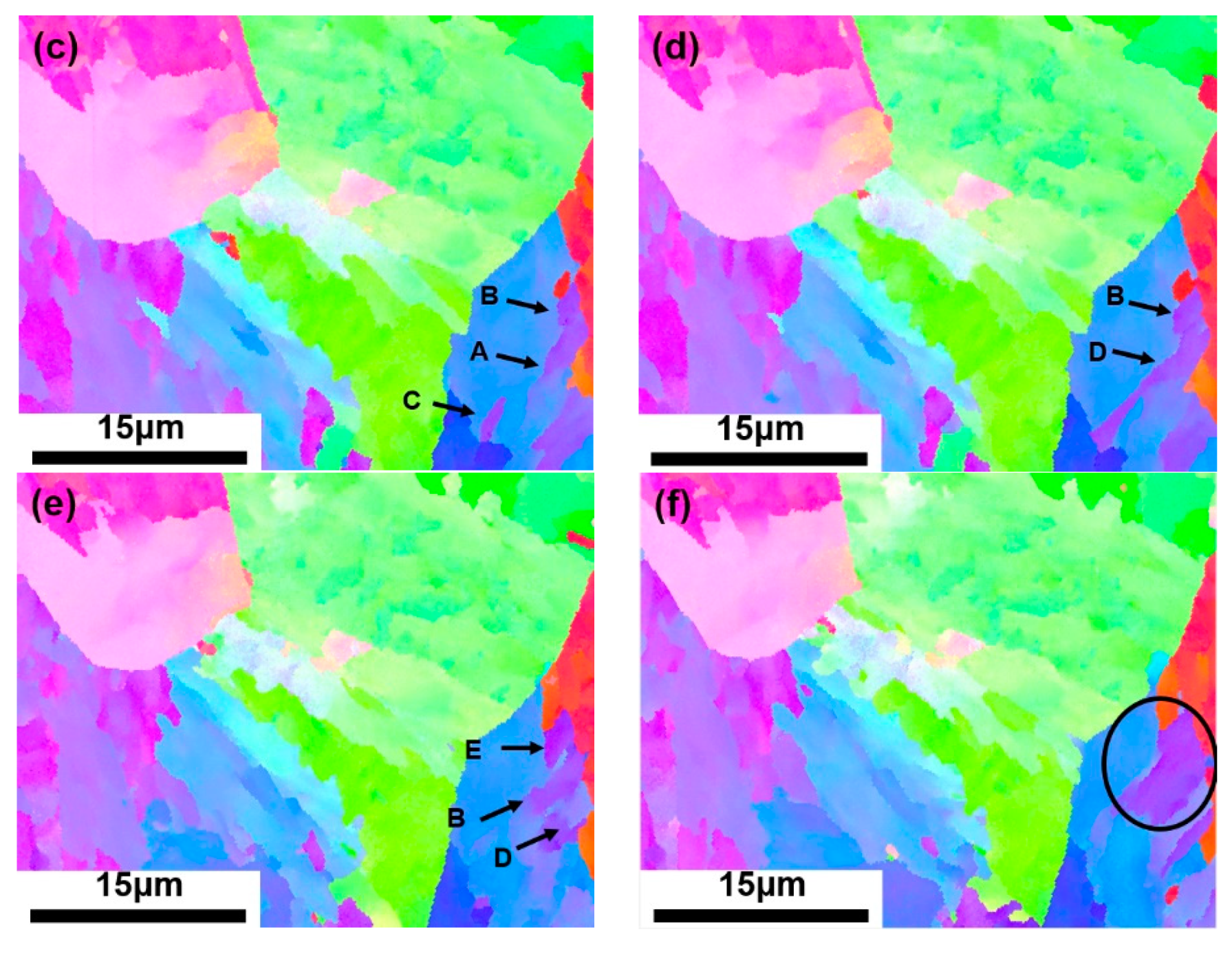
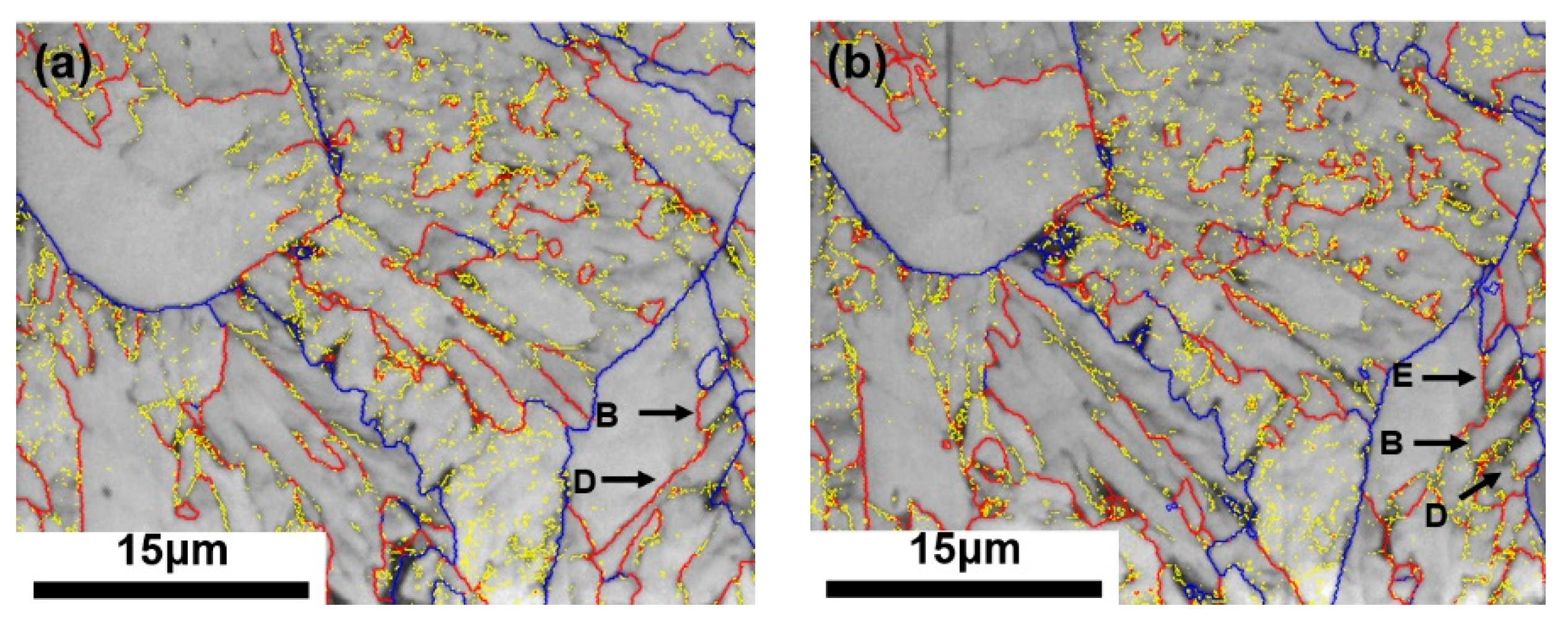



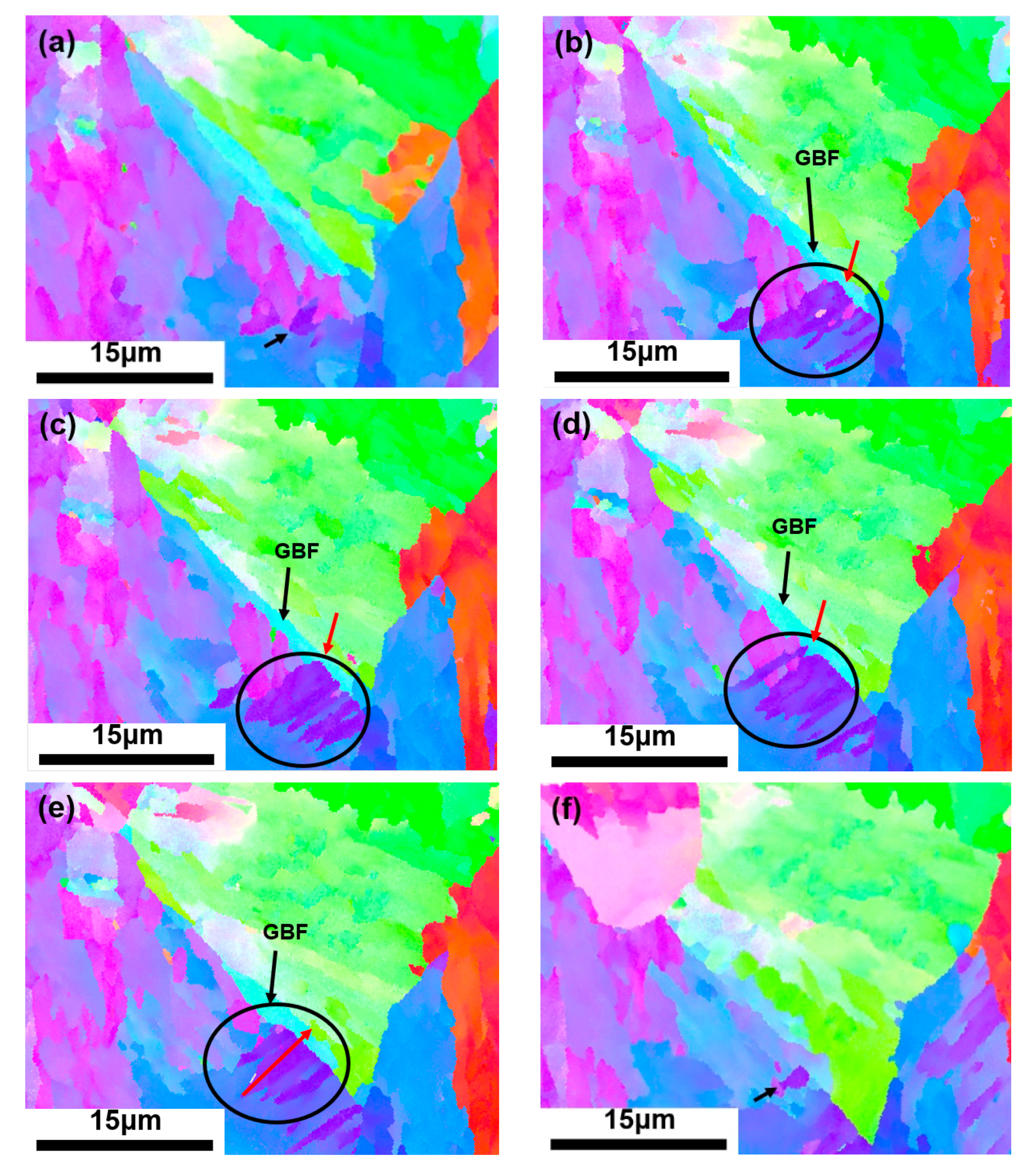
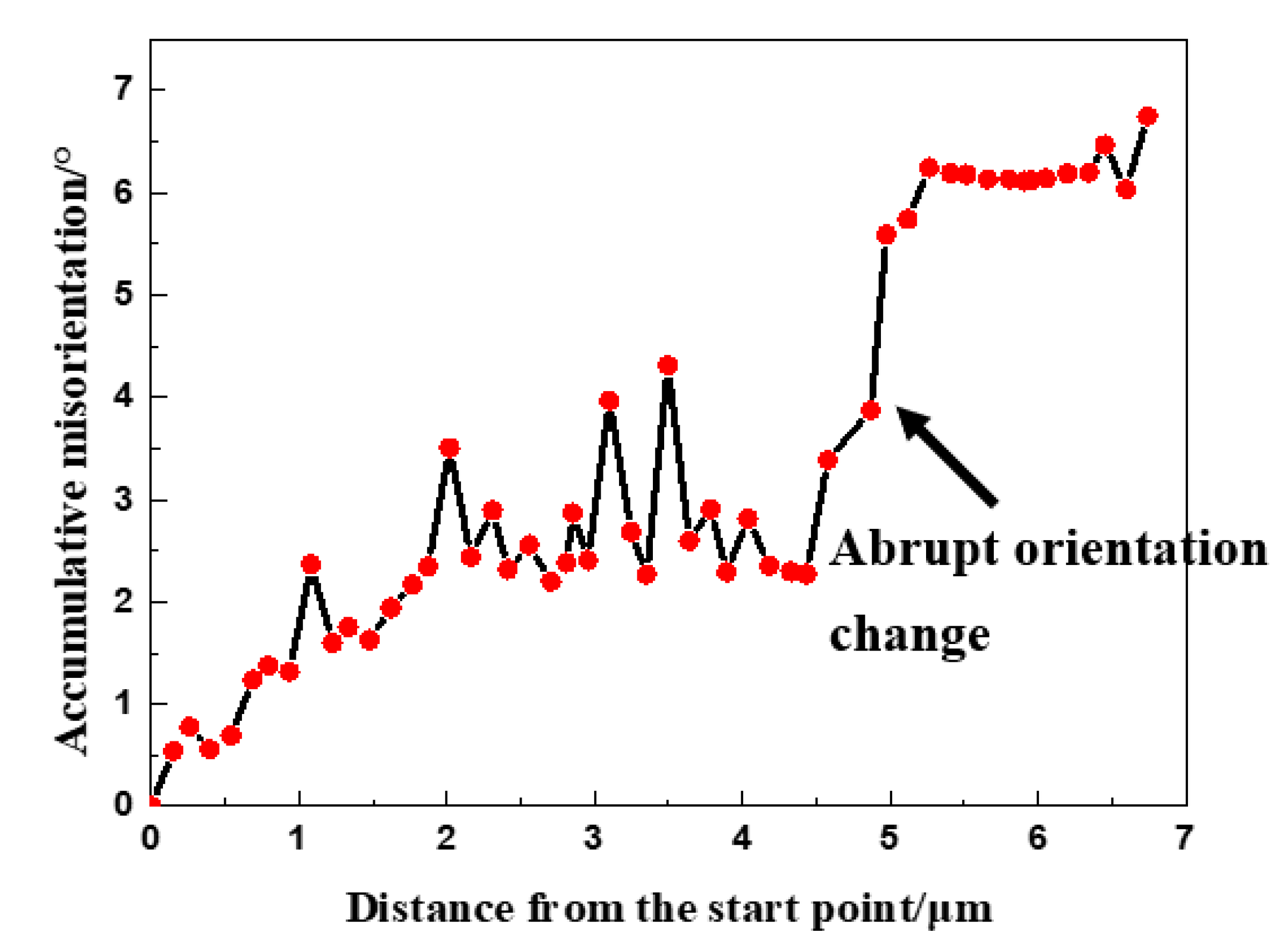
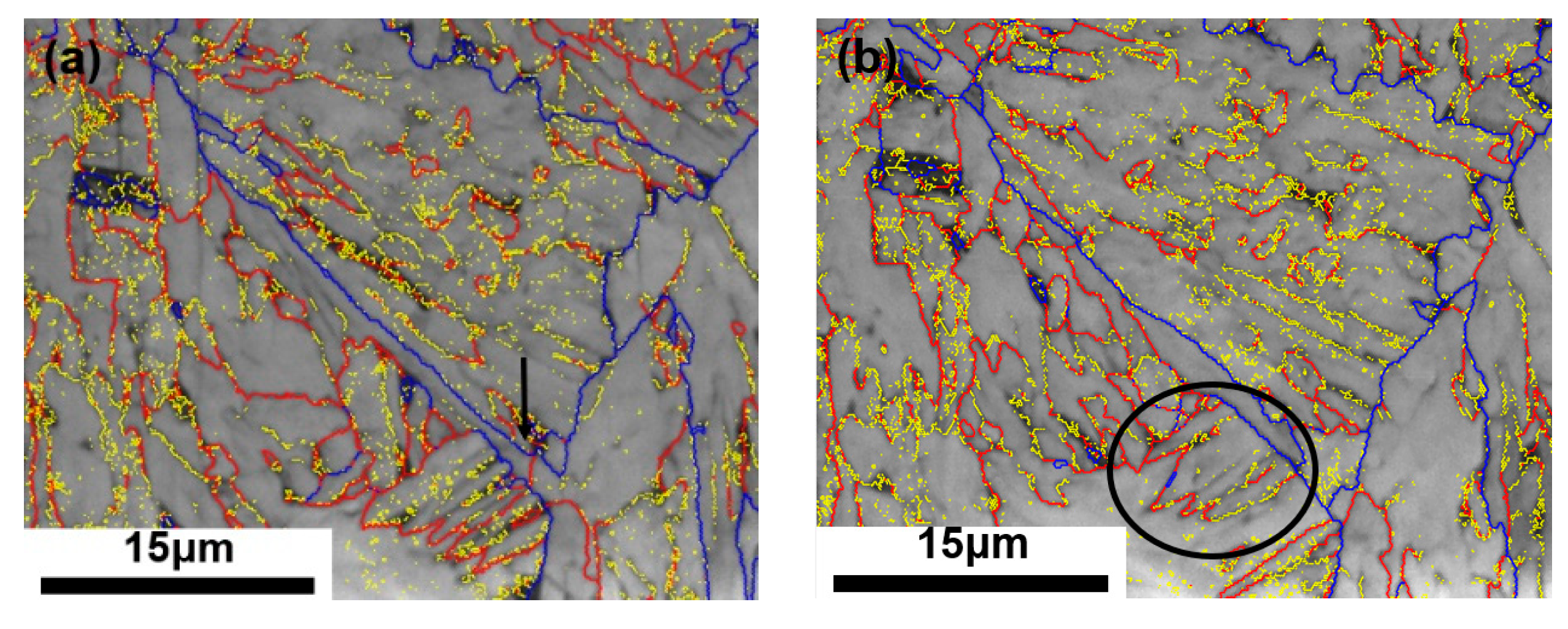

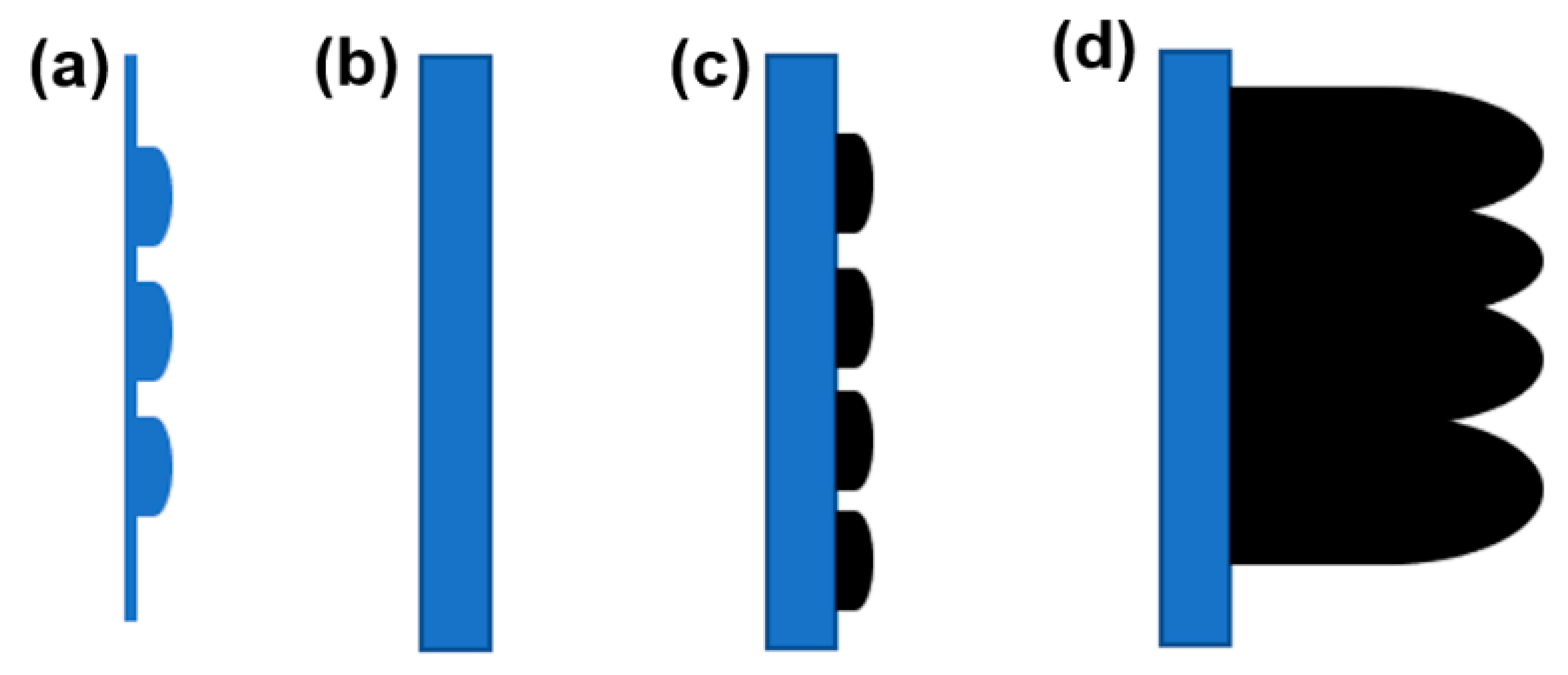
| Ingredient | C | Si | Mn | P | S | Al | Mo | Cu | Ni | V | Nb | Ti | Cr |
| Composition | 0.07 | 0.28 | 1.62 | 0.01 | 0.004 | 0.04 | 0.07 | 0.008 | 0.004 | 0.005 | 0.02 | 0.017 | 0.02 |
Publisher’s Note: MDPI stays neutral with regard to jurisdictional claims in published maps and institutional affiliations. |
© 2022 by the authors. Licensee MDPI, Basel, Switzerland. This article is an open access article distributed under the terms and conditions of the Creative Commons Attribution (CC BY) license (https://creativecommons.org/licenses/by/4.0/).
Share and Cite
Cao, S.; Wu, S.; Zhang, C.; Zhang, Q. Three-Dimensional Morphology and Analysis of Widmanstätten Sideplates Ferrite. Metals 2022, 12, 523. https://doi.org/10.3390/met12030523
Cao S, Wu S, Zhang C, Zhang Q. Three-Dimensional Morphology and Analysis of Widmanstätten Sideplates Ferrite. Metals. 2022; 12(3):523. https://doi.org/10.3390/met12030523
Chicago/Turabian StyleCao, Shengli, Shaowen Wu, Caijun Zhang, and Qingjun Zhang. 2022. "Three-Dimensional Morphology and Analysis of Widmanstätten Sideplates Ferrite" Metals 12, no. 3: 523. https://doi.org/10.3390/met12030523
APA StyleCao, S., Wu, S., Zhang, C., & Zhang, Q. (2022). Three-Dimensional Morphology and Analysis of Widmanstätten Sideplates Ferrite. Metals, 12(3), 523. https://doi.org/10.3390/met12030523





